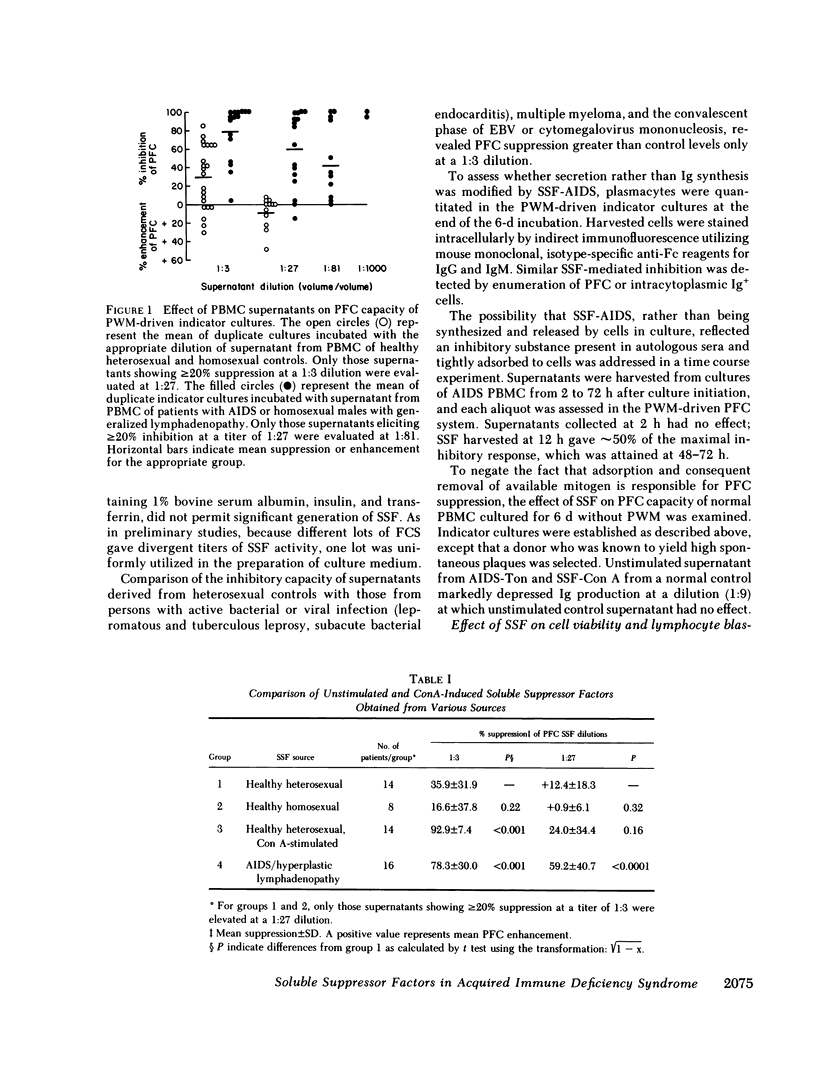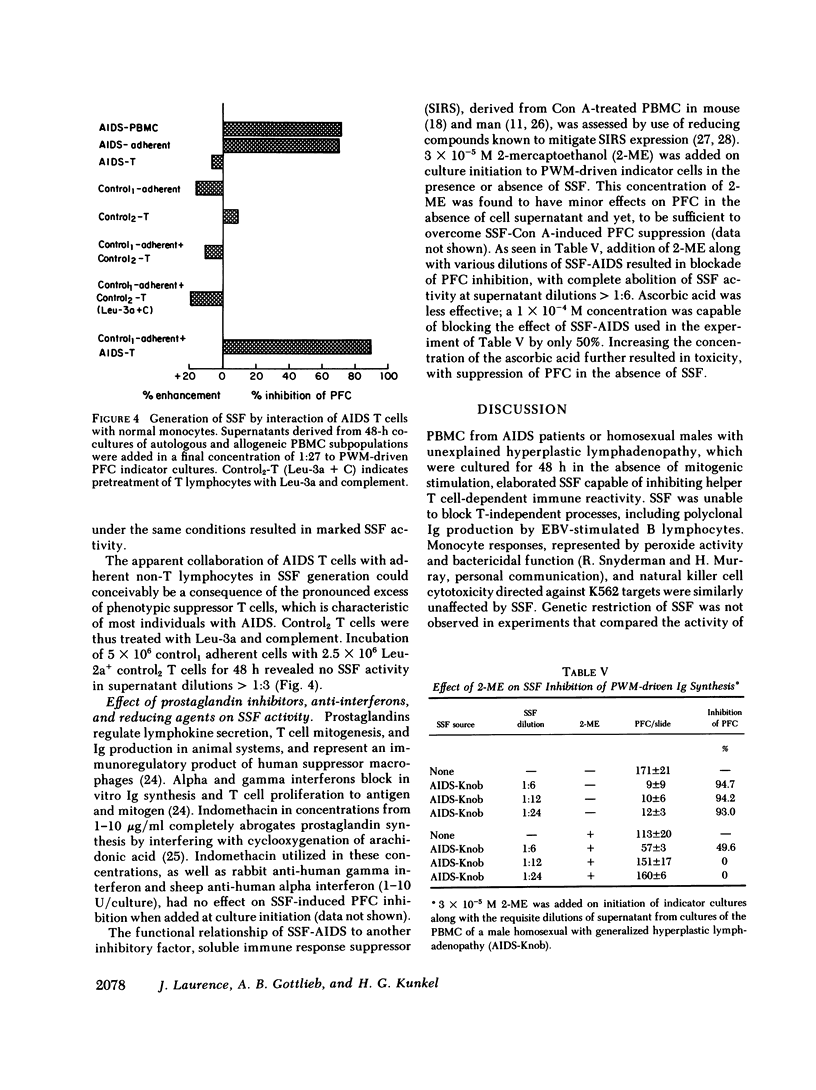Abstract
Supernatants from peripheral blood mononuclear cells obtained from certain patients with the acquired immune deficiency syndrome (AIDS) or its prodrome were capable of depressing spontaneous and pokeweed mitogen-driven B lymphocyte differentiation into plasmacytes, and the proliferative responses of T cells to specific antigen. These soluble suppressor factors (SSF) were present in uniquely high concentrations, with significant differences from healthy controls and from patients with various other conditions previously associated with factor-mediated immunosuppression. T cell-independent functions were not modified by SSF. Suppression was not genetically constrained, and did not appear to be mediated by cytotoxicity, prostaglandin, or alpha or gamma interferons. SSF was a product of the interaction of T lymphocytes with adherent cells. T cells or T cell factors from AIDS patients, but not from normal controls, could collaborate with control adherent cells in the formation of SSF. Restoration of DNA synthesis-independent differentiation of B lymphocytes into plasmacytes in SSF-treated cultures was realized by addition of reducing agents, such as 2-mercaptoethanol, on culture initiation. These data suggest inhibitory mechanisms possibly related to that of concanavalin A-induced soluble immune response suppression, and perhaps offer clues to clinically applicable substances which are potentially capable of mitigating such responses.
Full text
PDF









Selected References
These references are in PubMed. This may not be the complete list of references from this article.
- Austyn J. M., Steinman R. M., Weinstein D. E., Granelli-Piperno A., Palladino M. A. Dendritic cells initiate a two-stage mechanism for T lymphocyte proliferation. J Exp Med. 1983 Apr 1;157(4):1101–1115. doi: 10.1084/jem.157.4.1101. [DOI] [PMC free article] [PubMed] [Google Scholar]
- Bodel P. T., Nichols B. A., Bainton D. F. Appearance of peroxidase reactivity within the rough endoplasmic reticulum of blood monocytes after surface adherence. J Exp Med. 1977 Feb 1;145(2):264–274. doi: 10.1084/jem.145.2.264. [DOI] [PMC free article] [PubMed] [Google Scholar]
- Ellner J. J. Suppressor cells of man. Clin Immunol Rev. 1981;1(1):119–214. [PubMed] [Google Scholar]
- Fauci A. S. Human B cell function in a polyclonally induced plaque forming cell system. Cell triggering and immunoregulation. Immunol Rev. 1979;45:93–116. doi: 10.1111/j.1600-065x.1979.tb00274.x. [DOI] [PubMed] [Google Scholar]
- Fleisher T. A., Greene W. C., Blaese R. M., Waldmann T. A. Soluble suppressor supernatants elaborated by concanavalin A-activated human mononuclear cells. II. Characterization of a soluble suppressor of B cell immunoglobulin production. J Immunol. 1981 Mar;126(3):1192–1197. [PubMed] [Google Scholar]
- Gmelig-Meyling F., Waldmann T. A. Human B cell activation in vitro: augmentation and suppression by monocytes of the immunoglobulin production induced by various B cell stimulants. J Immunol. 1981 Feb;126(2):529–537. [PubMed] [Google Scholar]
- Gottlieb M. S., Schroff R., Schanker H. M., Weisman J. D., Fan P. T., Wolf R. A., Saxon A. Pneumocystis carinii pneumonia and mucosal candidiasis in previously healthy homosexual men: evidence of a new acquired cellular immunodeficiency. N Engl J Med. 1981 Dec 10;305(24):1425–1431. doi: 10.1056/NEJM198112103052401. [DOI] [PubMed] [Google Scholar]
- Greene W. C., Fleisher T. A., Waldmann T. A. Soluble suppressor supernatants elaborated by concanavalin A-activated human mononuclear cells. I. Characterization of a soluble suppressor T cell proliferation. J Immunol. 1981 Mar;126(3):1185–1191. [PubMed] [Google Scholar]
- Gronowicz E., Coutinho A., Melchers F. A plaque assay for all cells secreting Ig of a given type or class. Eur J Immunol. 1976 Aug;6(8):588–590. doi: 10.1002/eji.1830060812. [DOI] [PubMed] [Google Scholar]
- Gullberg M., Ivars F., Coutinho A., Larsson E. L. Regulation of T cell growth factor production: arrest of TCGF production after 18 hours in normal lectin-stimulated mouse spleen cell cultures. J Immunol. 1981 Aug;127(2):407–411. [PubMed] [Google Scholar]
- Hutchins D., Steel C. M. Phytohaemagglutinin-induced proliferation of human T lymphocytes: differences between neonate and adults in accessory cell requirements. Clin Exp Immunol. 1983 May;52(2):355–364. [PMC free article] [PubMed] [Google Scholar]
- Kabelitz D., Kunkel H. G. Phorbolester-treated human lymphocytes are susceptible to natural killer cell-mediated cytolysis. J Immunol. 1983 Jun;130(6):2505–2507. [PubMed] [Google Scholar]
- Kennard J., Zolla-Pazner S. Origin and function of suppressor macrophages in myeloma. J Immunol. 1980 Jan;124(1):268–273. [PubMed] [Google Scholar]
- Kirchner H., Chused T. M., Herberman R. B., Holden H. T., Lavrin D. H. Evidence of suppressor cell activity in spleens of mice bearing primary tumors induced by Moloney sarcoma virus. J Exp Med. 1974 Jun 1;139(6):1473–1487. doi: 10.1084/jem.139.6.1473. [DOI] [PMC free article] [PubMed] [Google Scholar]
- Kornfeld H., Vande Stouwe R. A., Lange M., Reddy M. M., Grieco M. H. T-lymphocyte subpopulations in homosexual men. N Engl J Med. 1982 Sep 16;307(12):729–731. doi: 10.1056/NEJM198209163071206. [DOI] [PubMed] [Google Scholar]
- Krakauer R. S., Strober W., Rippeon D. L., Waldmann T. A. Prevention of autoimmunity in experimental lupus erythematosus by soluble immune response suppressor. Science. 1977 Apr 1;196(4285):56–59. doi: 10.1126/science.300174. [DOI] [PubMed] [Google Scholar]
- Kurland J. I., Bockman R. Prostaglandin E production by human blood monocytes and mouse peritoneal macrophages. J Exp Med. 1978 Mar 1;147(3):952–957. doi: 10.1084/jem.147.3.952. [DOI] [PMC free article] [PubMed] [Google Scholar]
- Litwin S. D. Characteristics of suppressor cell activity appearing in cocultures of two individuals with immunodeficiency with thymoma. Scand J Immunol. 1980;11(1):15–22. doi: 10.1111/j.1365-3083.1980.tb00203.x. [DOI] [PubMed] [Google Scholar]
- Macek C. Acquired immunodeficiency syndrome cause(s) still elusive. JAMA. 1982 Sep 24;248(12):1423-7, 1431. doi: 10.1001/jama.248.12.1423. [DOI] [PubMed] [Google Scholar]
- Masur H., Michelis M. A., Greene J. B., Onorato I., Stouwe R. A., Holzman R. S., Wormser G., Brettman L., Lange M., Murray H. W. An outbreak of community-acquired Pneumocystis carinii pneumonia: initial manifestation of cellular immune dysfunction. N Engl J Med. 1981 Dec 10;305(24):1431–1438. doi: 10.1056/NEJM198112103052402. [DOI] [PubMed] [Google Scholar]
- Miyawaki T., Moriya N., Nagaoki T., Kubo M., Yokoi T., Taniguchi N. Mode of action of humoral suppressor factor derived from pokeweed mitogen-stimulated cord T cells of adult B cell differentiation. J Immunol. 1981 Jan;126(1):282–285. [PubMed] [Google Scholar]
- Pierce C. W., Johnson B. M., Gershon H. E., Asofsky R. Immune responses in vitro. 3. Development of primary gamma-M, gamma-G, and gamma-A plaque-forming cell responses in mouse spleen cell cultures stimulated with heterologous erythrocytes. J Exp Med. 1971 Aug 1;134(2):395–416. doi: 10.1084/jem.134.2.395. [DOI] [PMC free article] [PubMed] [Google Scholar]
- Sonnabend J., Witkin S. S., Purtilo D. T. Acquired immunodeficiency syndrome, opportunistic infections, and malignancies in male homosexuals. A hypothesis of etiologic factors in pathogenesis. JAMA. 1983 May 6;249(17):2370–2374. [PubMed] [Google Scholar]
- Stahl R. E., Friedman-Kien A., Dubin R., Marmor M., Zolla-Pazner S. Immunologic abnormalities in homosexual men. Relationship to Kaposi's sarcoma. Am J Med. 1982 Aug;73(2):171–178. doi: 10.1016/0002-9343(82)90174-7. [DOI] [PubMed] [Google Scholar]
- Stobo J. D. Immunosuppression in man: suppression by macrophages can be mediated by interactions with regulatory T cells. J Immunol. 1977 Sep;119(3):918–924. [PubMed] [Google Scholar]
- Stobo J. D., Paul S., Van Scoy R. E., Hermans P. E. Suppressor thymus-derived lymphocytes in fungal infection. J Clin Invest. 1976 Feb;57(2):319–328. doi: 10.1172/JCI108283. [DOI] [PMC free article] [PubMed] [Google Scholar]
- Stout R. D., Fisher M. Suppression of lymphocyte proliferative responses: demonstration of two stages occurring in the in vitro generation of suppressor macrophages. J Immunol. 1983 Apr;130(4):1580–1585. [PubMed] [Google Scholar]
- Tadakuma T., Pierce C. W. Mode of action of a soluble immune response suppressor (SIRS) produced by concanavalin a-activated spleen cells. J Immunol. 1978 Feb;120(2):481–486. [PubMed] [Google Scholar]
- Truitt G. A., Dennison D. K., Rich R. R., Rich S. S. Interaction between T cells and non-T cells in suppression of cytotoxic lymphocyte responses. J Immunol. 1979 Aug;123(2):745–750. [PubMed] [Google Scholar]
- Uytdehaag F., Heijnen C. J., Pot K. H., Ballieux R. E. Antigen-specific human T cell factors. II. T cell suppressor factor: biologic properties. J Immunol. 1981 Feb;126(2):503–507. [PubMed] [Google Scholar]
- Warrington R. J., Sauder P. J., Olivier S. L., Rutherford W. J., Wilkins J. A. A human T cell-derived soluble factor able to suppress pokeweed mitogen-induced immunoglobulin production. J Immunol. 1983 Jan;130(1):237–241. [PubMed] [Google Scholar]


